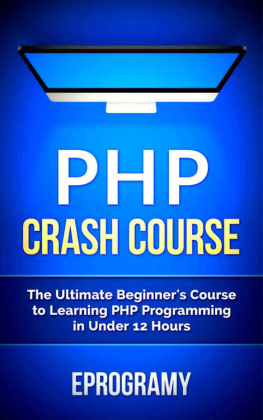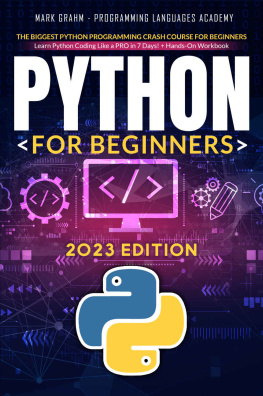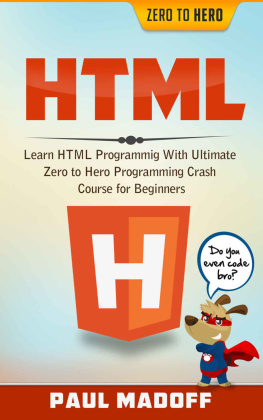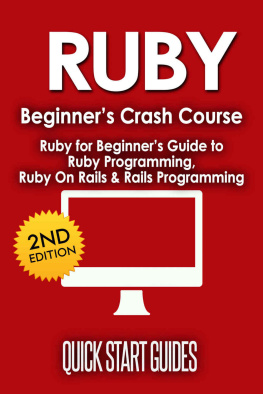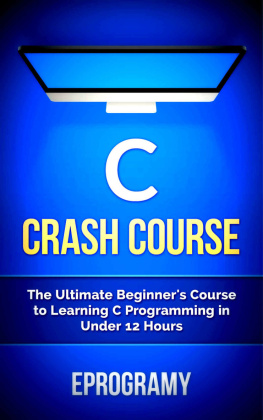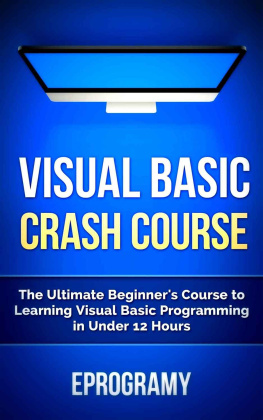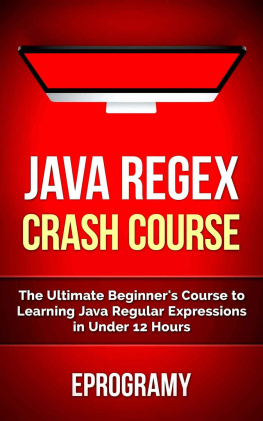PHP: Crash Course - The Ultimate Beginners Course to Learning PHP Programming in Under 12 Hours
Here you can read online PHP: Crash Course - The Ultimate Beginners Course to Learning PHP Programming in Under 12 Hours full text of the book (entire story) in english for free. Download pdf and epub, get meaning, cover and reviews about this ebook. genre: Computer. Description of the work, (preface) as well as reviews are available. Best literature library LitArk.com created for fans of good reading and offers a wide selection of genres:
Romance novel
Science fiction
Adventure
Detective
Science
History
Home and family
Prose
Art
Politics
Computer
Non-fiction
Religion
Business
Children
Humor
Choose a favorite category and find really read worthwhile books. Enjoy immersion in the world of imagination, feel the emotions of the characters or learn something new for yourself, make an fascinating discovery.
PHP: Crash Course - The Ultimate Beginners Course to Learning PHP Programming in Under 12 Hours: summary, description and annotation
We offer to read an annotation, description, summary or preface (depends on what the author of the book "PHP: Crash Course - The Ultimate Beginners Course to Learning PHP Programming in Under 12 Hours" wrote himself). If you haven't found the necessary information about the book — write in the comments, we will try to find it.
With Tons of Detailed Step by Step Procedures Inside!Are you ready to unlock the keys to the future? If your answer is a resounding YES!, then this crash course on PHP Programming is exactly what you need in your toolkit. In these days of the 3.0 era, there are essential tools that we must absolutely have at hand to solve everyday problems. And guess what? One of these skills consists of. how to use programming languages. Can you imagine what we could do if wed knew how to write a simple instruction for our PC? What we could achieve if we could create from scratch something thatd solve problems in just seconds? That would be absolutely amazing: no limits, no boundaries, no frontiers. A whole new world of possibilities in front of us!Perhaps you are an amateur just getting started with PHP, or maybe you already know a few things about this exciting programming language and youd like to reach for the next level. Which one are you? Actually, it doesnt matter! This course will approach PHP Programming from both starting points! The aim is to achieve all the necessary skills to learn how to program PHP in under 12 hours. Yes, I said it! 12 hours. In less than half a day you will incorporate the ABCS of PHP, and from there youll develop the advanced techniques you need to create your own projects.Want to hear the best part? This is not a mere theoretical book. Not at all. In here, youll find tons of useful exercises and tasks that will take your PHP skills (and overall, your whole programming skills) to a whole new level. Youll experience in first person how simple and entertaining PHP can be! This book will assist you not only to develop and improve your skills, but most importantly, it will help you unlock the joy learning a new programming language can unexpectedly bring. You can be sure of that!The idea were proposing is quite simple. You will learn PHP from zero to hero, in less than half a day. We will go from the root to the top of this ground-breaking programming language, and from there well build the solid foundations you are looking for. And at the end you will find a special bonus! Sounds good? So lets go for it!Here Is A Preview Of What Youll Learn Inside.Welcome To Your New Programming Language
History of PHP
What is PHP?
Setting up MySQL and PHP
Basics of HTML and CSS
PHP Variables
PHP Operators
Boolean Logic
Loops and Arrays
Functions and Classes
Useful Functions in PHP
Debugging
Login System Creation
Registration System Creation
Much, much more!
Unknown: author's other books
Who wrote PHP: Crash Course - The Ultimate Beginners Course to Learning PHP Programming in Under 12 Hours? Find out the surname, the name of the author of the book and a list of all author's works by series.

